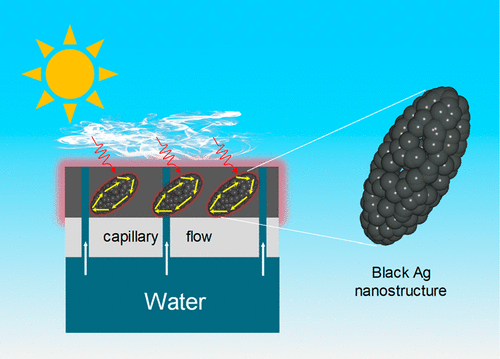One way to produce clean water is to heat dirty water until it turns into steam. As the steam rises, it leaves behind the heavier contaminants and can be collected and cooled, providing clean water. There are many ways to heat water, one of which is to use light-absorbing materials at the air/water interface to harvest sunlight and convert the light into heat. This method is very energy-efficient because all of the absorbed solar energy is used to heat water near the surface, rather than heating the entire body of water.
Now in a new study published in Nano Letters, a team of researchers led by Mozhen Wang at the University of Science and Technology of China and Yadong Yin at the University of California Riverside has demonstrated a method that significantly improves the efficiency of solar steam generation using light-absorbing plasmonic metal nanostructures.
Plasmonic metal nanostructures are a popular new material for many photonics applications, including solar cells and optical imaging, since they interact with light in unique ways and can be engineered to exhibit desirable properties. For solar steam generation, for example, they can be modified to have high light absorption and low scattering properties.
One limitation, however, is that plasmonic nanostructures have a narrow resonant band and so they can absorb only a small portion of the solar spectrum. In the new study, the researchers’ main result was greatly expanding the narrow resonant band of the plasmonic silver nanoparticles.
“We have demonstrated that metal nanostructures can be engineered by chemical synthesis to become very effective in converting broad-spectrum light into heat, enabling efficient solar steam generation,” Yin told.
The improvement is based on a concept called plasmonic coupling. When two plasmonic nanoparticles come close together, their resonance modes hybridize, which broadens their combined resonance band and allows them to absorb light of a wider range of frequencies.
Although this method has been tried before, it has resulted only in small improvements in spectral broadening. In the new study, the researchers greatly enhanced the performance using a confined seeded growth method to ensure that more nanoparticles are close enough together to experience the effects. In the seeded growth method, seeds are fixed on the inner surface of polymer nanoshells in a random distribution so that, as the seeds grow into plasmonic nanoparticles, they grow closer together. This method ensures a high density of nanoparticles that benefit from the space confinement and exhibit broadband light absorption.
The researchers calculated that the new method could achieve solar steam generation efficiencies as high as 95%, which is one of the highest efficiencies to date. In tests with natural sunlight, the nanoparticles achieved an efficiency of 68%. The researchers plan to further improve the nanostructures in the future.
“Our immediate next step is to develop black nanostructures using non-previous metals such as copper and aluminum,” Yin said. “The goal is to reduce the production costs and make efficient solar steam generation more economically viable for large-scale use.”
